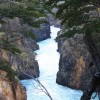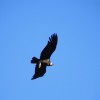
Tracking the huemul at the Baker River
by Luigi Solis
Photo Gallery:
 When we arrived at the “Eses,” we split into three walking groups, fanning out to survey the terrain. I took the path closest to the Baker River: since few may have the privilege of walking by this river in its natural state, I wanted to record and share the experience through photographs. Almost immediately, we found several sets of fresh huemul tracks, possibly only a day old. For a long time, we walked following these tracks, waiting to find the animals that made them, to know for certain they had made a home here.
When we arrived at the “Eses,” we split into three walking groups, fanning out to survey the terrain. I took the path closest to the Baker River: since few may have the privilege of walking by this river in its natural state, I wanted to record and share the experience through photographs. Almost immediately, we found several sets of fresh huemul tracks, possibly only a day old. For a long time, we walked following these tracks, waiting to find the animals that made them, to know for certain they had made a home here.
After walking along the tracks for several hours, we had yet to find the huemuls themselves. We regrouped and shared some lunch as we re-evaluated our route and surveying method. Two options presented themselves for the afternoon: continue along our path, walking downstream along the Baker, or move to a different sector. Any way we proceeded, our chances of sighting these shy and rare deer remained low. Continuing along our previous route well might yield nothing. Yet changing course and searching the new area seemed perhaps even more unlikely, since livestock grazed in that area. As we finished our lunch, we resolved to continue on downstream towards the Chacabuco-Baker Confluence, once again following the fresh tracks of the huemul.
 Right then, we caught sight of two, then three, and finally four huemul deer, docile and serene. As we studied them, we determined that their little band consisted of an adult male, a juvenile female, a young female, and one fawn. The male, Daniel realized, was Silencio, an animal he had tracked since birth but had lost contact with years before. He tells the story of Silencio’s life below.
Right then, we caught sight of two, then three, and finally four huemul deer, docile and serene. As we studied them, we determined that their little band consisted of an adult male, a juvenile female, a young female, and one fawn. The male, Daniel realized, was Silencio, an animal he had tracked since birth but had lost contact with years before. He tells the story of Silencio’s life below.Watching them watch us, we stood spellbound, and felt in our bones an obligation to help them survive in this land they call home. We returned to the park deeply stirred by the creatures we had seen, so quietly dwelling in that fated landscape. That evening, I sat down to describe what made this huemul sighting so stirring. All of us have spent years watching these deer, but felt especially lucky be the first ones to record huemul in this place, slated for flooding if the HidroAysen project proceeds.
Son of hardworking and humble country people, I consider myself a Patagonian in and out. My family lived almost self-sufficiently in a remote area. Milking cows, planting gardens, making hay for harsh winters, and tending our small herd of sheep were my childhood pastimes. For years, I did not attend school, but when I got the opportunity, I studied with the same determination I had brought to farm chores. Although only simple farmers, my parents managed to pay for my technical studies and for those of my two sisters. I am proud of my Patagonia: its hardworking people who brave tough conditions, its mountains and rivers, and its wildlife. As a Patagonian, I will defend this place.

_______________________
Silencio’s story
by Daniel Velasquez
It was November of 2006, and we had spent several days following a pregnant female huemul named “Puntilla” to know when she gave birth. As part of our huemul monitoring program, we use radio collars and telemetry to follow pregnant mothers, so that we can find and monitor their offspring soon after birth. Newborn fawns suffer high rates of mortality, so insuring a future for the species depends on investigating major threats to fawns.
Puntilla gave birth on November 21, tucked away in the rocky terraces of the northern shore of the Cochrane River. She had hidden herself and her fawn well, making it challenging to locate them. As we observed the pair together and then placed an ear tag in the young fawn, he made not one sound. “Silencio,” we decided, would be a fitting name for this quiet animal.
For the next year, I saw Silencio often during my days tracking huemuls, taking many photographs of his development. Always near his mother, he moved along the shores of the Cochrane River, gradually moving closer to its confluence with the Baker River.
When Silencio reached one year of age, his mother moved from this area : when female huemuls are about to give birth to a new fawn, they will often leave behind their year-old young to devote their energy to the newborn. She gave birth to her fawn, but Silencio seemed to have disappeared. His radio transmitter had stopped working. Although we searched for him carefully, we could find not a trace and never saw him in the park again. Since we found no evidence he had died, we classified him as “missing” in our study.

For five years, I followed Puntilla, who still lives in the headquarters of the Cochrane River. Through tracking and monitoring her, I have recorded all her pregnancies and tagged all her young. Yet of all her offspring, only Silencio made it to adulthood.
Rumors from neighbors of small family group of huemuls living along the Baker prompted us to survey this area, never before considered territory of the huemul. On the day Luigi recounts above, we not only saw huemuls in this area for the first time, but also rediscovered Silencio after four and a half years. Although his transmitter no longer functioned, his ear tag allowed us to identify him.
To our surprise and delight, Silencio had survived to seek new lands and establish his own territory, clearly marked with his antler scrapings on trees. He had established a new family with various females and their offspring. Silencio appears well on his way to becoming the pioneer of a new population of huemuls in this area.
Silencio selected his territory wisely: on the steep banks of the Baker River, this area is forested and away from herds of livestock. But as he made a home and family here, Silencio could not know the human plans for the region. With the construction of HidroAysen’s Baker 1 megadam, his new home territory will be flooded. Heavy machinery and hundreds of construction workers will invade his silence, chopping their way through his home forests.
We returned to the park that evening inspired by these wild animals’ ability to survive and thrive, yet the knowledge of the fate of this area clouded our delight. We share this story of the huemuls of the Baker River to tell the people of Chile how their totem animal, a proud presence on the national shield, is at stake in this decision.



































.gif)



